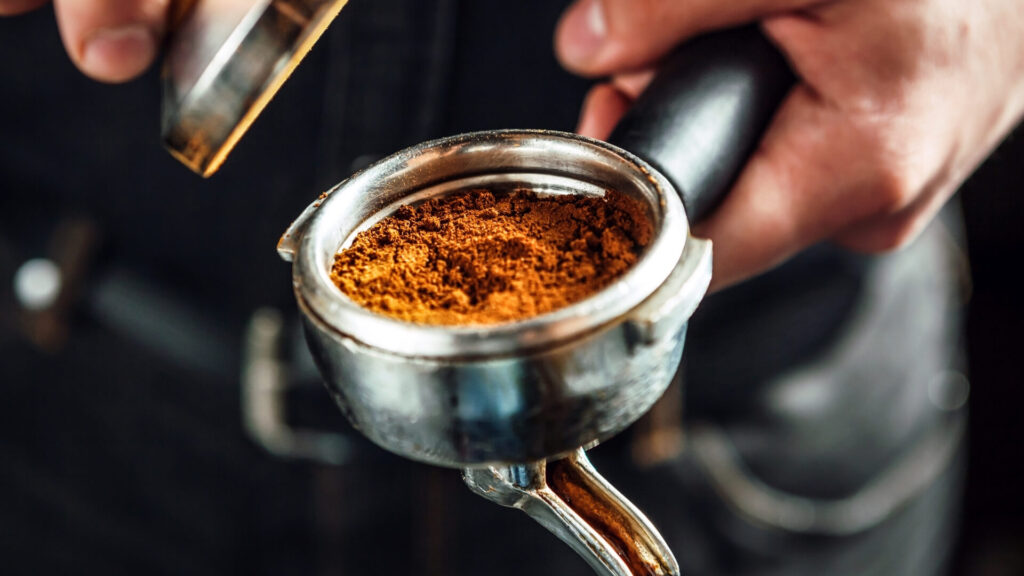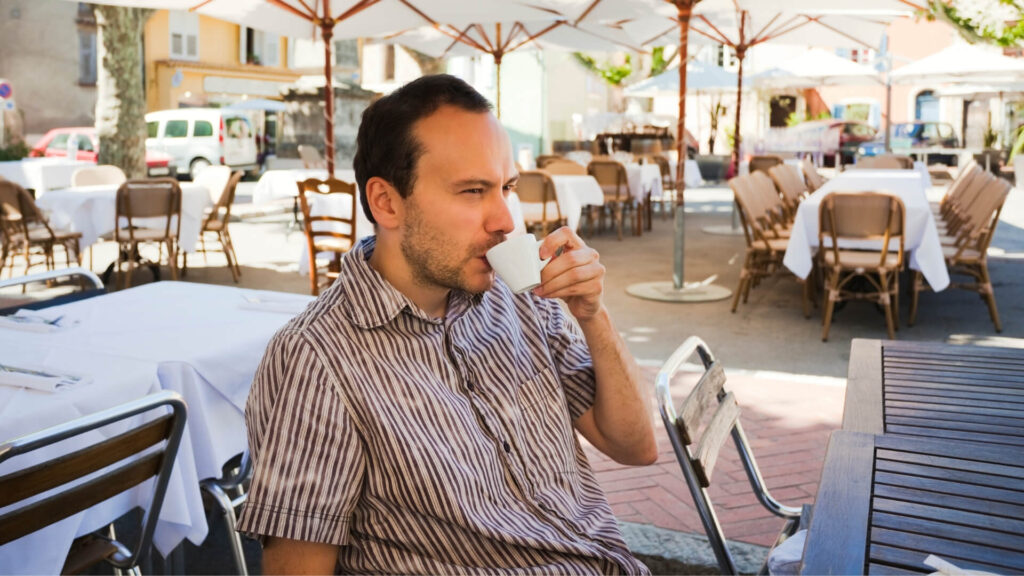In this article, we will explore the differences between Turkish coffee and espresso in depth.
Espresso is a coffee drink made by forcing pressurized water through finely-ground coffee beans. On the other hand, Turkish coffee is made by boiling coffee grounds in a pot on the stove before being poured into cups.
The preparation methods and ingredients used in making these two drinks are quite different. Espresso uses more pressure to extract flavor from the coffee grounds, while Turkish coffee relies mainly on time for extraction instead of force.
These differences result in distinct taste profiles and brewing traditions for each drink.
What is Turkish Coffee?

Turkish coffee is a popular coffee preparation style in Turkey, made by boiling finely ground coffee beans in water.
It can be enjoyed black or with sugar and is often consumed during conversations.
The drink’s origins can be traced back to Ottoman scholar Hadji Murad Inan in the 16th century, who mixed boiled wheat grains with roasted barley and chickpeas to create a powder similar to Turkish coffee.
Over time, the recipe has evolved to produce a fine grind that produces the best results when boiled with water.
Turkish coffee is a significant custom in Turkey, where it is often served as an invitation to visit someone’s home, and hosts may play music and dance with their guests.

What is Espresso?
Espresso is a concentrated coffee made by forcing hot water through finely ground dark-roasted coffee beans under pressure.
This brewing method originated in Italy and gained popularity worldwide after World War II.
In the United States, espresso has become increasingly popular and is now a common way to make coffee at home.
Americans consume about 400 million cups of espresso each year(source), making it the most popular coffee choice in the country.
Its popularity is due in part to its quick preparation time, as it only takes 25 seconds to make a shot of espresso compared to 4 minutes for drip coffee.
This allows for a fast and flavorful caffeine fix at work or on the go without sacrificing taste or quality.
An Interesting Fact About Espresso:
The first machine for making espresso was designed and built-in in 1901 by Luigi Bezzera of Milan, Italy. The idea for the machine came from Bezzera’s desire to speed up the process of preparing coffee, which normally took several minutes per cup.
You can find more fun facts about espresso in the movie below:
What Is The Difference Between Turkish Coffee and Espresso?
| Aspect | Turkish coffee | Espresso |
| Brewing Method | Boiled in a special pot called a cezve/ibrik | Pressurized hot water forced through coffee grounds |
| Caffeine content | Approx 25mg per ounce | Approx 75mg per ounce |
| Serving Size | Small, typically 2-2.5 ounces (60-75 ml) | 1 ounce (30 ml) for a single shot, 2 ounces (60 ml) for a double |
| Coffee Grind | Extremely fine, almost like a powder | Fine, but slightly coarser than Turkish coffee |
| Coffee Beans | Arabica, or a mix of Arabica and Robusta | Arabica, Robusta, or a blend of both |
| Consistency | Thicker and more viscous, with coffee grounds settling at the bottom | Smooth and concentrated, with a creamy layer of crema on top |
| Flavor | Strong, rich, and bold, with a hint of sweetness | Intense, concentrated, and slightly bitter |
| Preparation Time | Slower, around 5-10 minutes | Faster, about 25-30 seconds |
| Serving Method | Served in small cups called “fincan” | Served in small ceramic or glass cups called “demitasse” |
| Additions | Often flavored with cardamom, sugar, or spices | Typically served plain or with sugar, can be used in various coffee drinks |
| Traditional Origin | Turkey and Middle Eastern countries | Italy and European countries |
Equipment and brewing method (Turkish coffee cup vs espresso cup)
You can easily make single servings at home using either an espresso machine or a stovetop Moka pot. Turkish coffee, on the other hand, is usually made with a cezve, which looks like a minor metal pitcher with a long handle and spout.
Turkish coffee is brewed by boiling finely ground coffee beans with water and, optionally, sugar in a special pot called a cezve or ibrik, which looks like a minor metal pitcher with a long handle and spout.
The mixture is heated until it starts to froth, removed from heat, and then returned to heat several times to create a rich and thick brew.
In contrast, espresso is prepared by forcing pressurized hot water through finely-ground coffee beans using an espresso machine. The result is a concentrated shot of coffee with a distinctive layer of crema on top.
You can easily make single servings at home using either an espresso machine or a stovetop Moka pot.
Caffeine and serving size
A standard serving of Turkish coffee is typically around 2-2.5 ounces and contains approximately 25mg of caffeine per ounce. This means that a typical serving of Turkish coffee contains approximately 50-62.5mg of caffeine.
In contrast, a standard serving of espresso is typically served in a 1-ounce (30 ml) cup and contains approximately 75mg of caffeine per ounce. This means that a typical serving of espresso contains approximately 75mg of caffeine.
Read next: How many espresso beans do I need in a shot?
Comparing the two, we can see that a single serving of espresso contains significantly more caffeine than a typical serving of Turkish coffee. In fact, a single shot of espresso contains more caffeine than a double serving of Turkish coffee.
It’s important to note, however, that the caffeine content of both Turkish coffee and espresso can vary depending on a variety of factors, including the brewing method, the type of coffee bean used, and the size of the serving.
Grinding Process

Turkish coffee requires an extremely fine grind, almost like a powder, which contributes to its unique texture and flavor. This ultra-fine grind allows the coffee particles to dissolve partially in the hot water, creating a thick and frothy consistency.
Espresso, on the other hand, uses a fine grind that is slightly coarser than Turkish coffee. This allows the pressurized water to pass through the coffee grounds, extracting the flavors and oils without over-extraction.
Best Beans Selection
Both Turkish coffee and espresso can be made using Arabica, Robusta, or a blend of both types of coffee beans.
However, the specific beans used may vary depending on regional preferences and individual tastes.
Turkish coffee is often 100% Arabica, while espresso blends can include a variety of Arabica and Robusta beans from different regions, chosen for their unique flavor profiles.
Best Beans for Turkish Coffee
As you already know Turkish coffee is prepared by boiling finely ground coffee to a very strong brew. This means that arabica beans are preferred, but robusta or a mix may be used too.
If you are just starting your adventure with Turkish coffee I highly recommend classic Najjar coffee. It is very smooth and strong, but not bitter at the same time. You also won’t be able to resist the amazing aroma. Definitely, a perfect way to make Turkish coffee.
Best Beans for Espresso
My number 1 recommendation is Kicking Horse Coffee. It’s made using 100% Arabica whole bean, this is a high-quality espresso coffee that’s strong and delicious. You also won’t feel the acidic taste because of lack of the robusta beans.
Taste

Espresso is a type of coffee that’s brewed under pressure, using finely ground beans. It results in a strong and bitter taste, with a thick crema on top. The flavor profile is acidic and slightly sweet.
Turkish coffee, on the other hand, is made by boiling finely ground coffee grinds in water for about 10 minutes to extract the oils before straining out the grounds. So if you are wondering what Turkish coffee taste like the answer is that it is more delicate than espresso but richer than drip-brewed coffee because it has less contact time with the hot water that drips through it into your cup. It has a slightly smoky or spicy flavor.
Preparation time
Turkish coffee takes longer to prepare, with the entire process taking around 5-10 minutes, as the coffee is heated, removed from heat, and reheated several times. Espresso, in contrast, takes only about 25-30 seconds to brew, as the hot water is quickly forced through the coffee grounds under pressure.
Serving
In addition to the specific cups used for serving each type of coffee, Turkish coffee is often flavored with cardamom, sugar, or spices, enhancing the overall experience.
Espresso is typically served plain or with sugar and can be used as a base for various coffee drinks, such as cappuccinos, lattes, and macchiatos.
Variations
Although people in Turkey drink their own brew, they also enjoy different varieties of coffee and sometimes add spices like cardamom to give them a unique flavor profile.
This type of brewing is known more globally as “Turkish coffee” and is also analogous to the style of espresso production because it uses a fine grind and water under pressure.
“Espresso Romano” is a very typical variant of espresso. Espresso Romano is made using regular espresso and a slice of lemon or lemon juice.
Health
When it comes to comparing the health aspects of Turkish coffee and espresso, some differences can be seen in terms of protein, carbohydrates, and fat content.
| Nutrient | Turkish Coffee (per 100g) | Espresso (per 100g) | Difference |
| Protein | 0.11g | 0.12g | |
| Carbohydrates | 6.49g | 1.67g | |
| Fat | 0.02g | 0.18g |
Espresso has slightly more protein than Turkish coffee, with 0.12g per 100g compared to 0.11g per 100g in Turkish coffee.
However, espresso has significantly fewer carbohydrates than Turkish coffee, with only 1.67g per 100g compared to 6.49g per 100g in Turkish coffee.
This difference amounts to about a 289% reduction in carbohydrates. On the other hand, espresso contains more fat than Turkish coffee, with 0.18g per 100g compared to 0.02g per 100g in Turkish coffee.
This difference amounts to about an 800% increase in fat content.
While these differences may be small, they can be important for individuals who are tracking their macronutrient intake or have specific dietary needs. It’s worth noting that both Turkish coffee and espresso can be enjoyed in moderation as part of a balanced diet.
Origin
Turkish coffee has its roots in Turkey and Middle Eastern countries, where it has been enjoyed for centuries as a cultural staple.
Espresso, on the other hand, originates in Italy and has spread throughout European countries, becoming a popular choice for coffee aficionados worldwide.
When comparing the strength of Turkish coffee and espresso, there are a few factors to consider, including caffeine content and flavor.
In terms of caffeine content, espresso typically contains more caffeine per ounce than Turkish coffee.
A single shot of espresso, which is typically served in a 30ml (1 ounce) cup, contains approximately 75mg of caffeine.
In contrast, a typical serving of Turkish coffee, which is usually 2-2.5 ounces and contains approximately 25mg of caffeine per ounce, contains approximately 50-62.5mg of caffeine.
However, it’s worth noting that Turkish coffee is often brewed to be very strong, with a rich and bold flavor profile that some people may find more intense than espresso.
Turkish coffee is made by grinding coffee beans to a very fine powder and then boiling the grounds in water with sugar, resulting in a thick and syrupy brew that is full of flavor.
The sweetness of the sugar helps to balance the bitterness of the coffee, creating a unique and complex flavor profile.
Espresso, on the other hand, results in a concentrated shot of coffee that is typically served in a small cup. Espresso has a strong and robust flavor, with a slightly bitter taste that is often balanced by the addition of milk or sugar.
In terms of which one is “stronger,” it really comes down to personal preference.
If you prefer a bold and intense coffee with a complex flavor profile, Turkish coffee may be the way to go. If you prefer a quick and concentrated shot of caffeine with a slightly bitter taste, espresso may be more your style.
Turkish coffee is not the same as espresso, although they share some similarities. Both are strong and flavorful coffee drinks, but they are made using different brewing methods and techniques.
While both Turkish coffee and espresso are strong and flavorful coffee drinks, they are distinct in their brewing methods, flavor profiles, and cultural traditions.
Therefore, Turkish coffee is not considered espresso.
Frequently Asked Questions about Turkish coffee and espresso

Is Turkish coffee stronger than espresso?
No. Turkish coffee is not stronger than espresso. A cup of Turkish coffee has around 50 milligrams of caffeine per espresso-sized cup while a cup of espresso has approx 64 mg of caffeine.
Is Turkish coffee stronger than regular coffee?
No Turkish coffee is not stronger than regular drip coffee. Turkish coffee is only stronger because it contains more grounds. For the same “serving size” of coffee, there are more grounds in a Turkish coffee pot than in a European/Mexican style pot.
Can I use Turkish coffee for espresso?
No, it’s not something I’d recommend. Turkish coffee will not produce the same results as coffee used for espresso. Espresso is a dry, dark-roasted bean that has been finely ground and heated under pressure to extract a portion of natural oils.
Turkish coffee tends to have a lower acid content and does not use heat in its process, which means the flavors are different. It doesn’t have the same thickness as espresso, so you will end up having more like a skinny coffee.
Further Reading
- What Does Espresso Taste Like: Jump deeper into the unique flavor profile of espresso as you compare it with Turkish coffee. Understand the nuances and complexity of espresso, which makes it distinct from other coffee preparations. Discover the taste of espresso here.
- How to Make Espresso: Interested in preparing espresso at home? Learn the techniques and equipment needed to craft the perfect espresso shot. Compare the process with that of making Turkish coffee and find the method that suits your taste. Master the art of making espresso here.
- Types of Coffee Beans: The choice of coffee beans plays a crucial role in defining the flavor of both espresso and Turkish coffee. Learn about the different types of coffee beans and how they impact the taste, aroma, and body of your favorite brew. Explore the world of coffee beans here.
- Best Italian Espresso Machines: If you find yourself leaning more towards espresso, consider investing in a high-quality espresso machine. Discover some of the best Italian espresso machines that will help you create authentic and delicious espresso shots at home. Find your perfect espresso machine here.
Conclusion
I’ve personally tried both Turkish coffee and espresso, but my vote goes for a shot of espresso. Espresso does have a smoother taste, so if you like your drinks on the sweeter side then this might be what you will prefer too.
If you don’t know where to start when deciding between these two types of brews, read our blog post about how they’re different in preparation time or equipment required.



